 THE
MAN AND THE MONSTER (1958)
THE
MAN AND THE MONSTER (1958)Director: Rafael Baledon
CasaNegra
 THE
MAN AND THE MONSTER (1958)
THE
MAN AND THE MONSTER (1958)Continuing a line of quality Mexi monster DVDs, CasaNegra has released two more fun films on the same street date: THE MAN AND THE MONSTER (“El Hombre Y El Monstruo”) and THE LIVING COFFIN (“El Grito De La Muerte”). These are two very different entries indeed, but both films were among many dubbed into English by K. Gordon Murray and brought directly to U.S. television by AIP-TV.
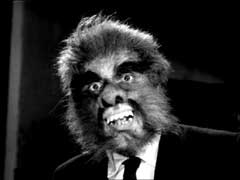
In THE MAN AND THE MONSTER, a concert promoter (Abel Salazar) arrives in town one night to discover an abandoned automobile and a young blonde viciously attacked. He is visiting to meet Samuel Manning (Enrique Rambal), a famed concert pianist who no longer performs in public. Samuel, who lives with his overbearing, black-cat clinching mother, is now instructing a pretty protégé named Laura (Martha Roth), who happens to resemble another famed pianist who has mysteriously disappeared. Samuel’s dark secret is that he sold his soul to the Devil in exchange for musical success, and now when ever he attempts to tickle the ivories, he turns into a rampaging werewolf-like monster.
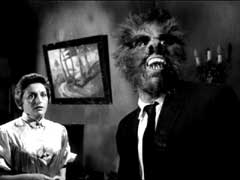 Mexican
monster movies always explored various hand-me-down themes, and this one combines
“Faust” with “Dr. Jekyll and Mr. Hyde,” resulting in
entertaining if somewhat campy results. Rambal’s monster is truly a Jekyll/Hyde
take-off in that he has a split personality and babbles constantly in his hairy
alter ego. With his brushy eyebrows, awkward canines and oversized meatball
nose, his memorable appearance is best summed up by one IMDB commentor: “The
monster looks like Scooby Doo in a tuxedo at times.”
Mexican
monster movies always explored various hand-me-down themes, and this one combines
“Faust” with “Dr. Jekyll and Mr. Hyde,” resulting in
entertaining if somewhat campy results. Rambal’s monster is truly a Jekyll/Hyde
take-off in that he has a split personality and babbles constantly in his hairy
alter ego. With his brushy eyebrows, awkward canines and oversized meatball
nose, his memorable appearance is best summed up by one IMDB commentor: “The
monster looks like Scooby Doo in a tuxedo at times.”
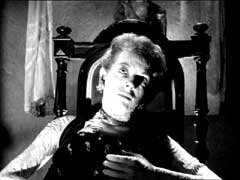
Abel Salazar (who also produced) is in familiar form as the sharp-dressed hero who’s never afraid to jump into a fight with the overzealous monster or protect beautiful Italian-born heroine Martha Roth. It takes a while for the monster action to set in, but when he does make his grand entrance, it’s fun to see him attacking a victim sleeping in hotel bed or transforming into the beast while conducting before a refined audience of concert goers (the transformations are done in a series of dissolves, much like the old Universal Wolf Man movies). THE MAN AND THE MONSTER doesn’t have too many striking camera shots like other Mexi horrors of the period, but much of the shadowy lighting in the gothic hacienda is well implemented and responsible for much of the film’s surreal atmosphere.
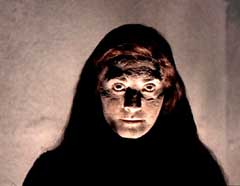 In
THE LIVING COFFIN, handsome clean-shaven cowboy Gastón (Gastón
Santo) and his useless rotund sidekick Coyote Loco (Pedro de Aguillón)
arrive in a strange town, carrying a red figurine idol. Professing to be a student
of archeology, Gastón is told by beautiful Maria (María Duval)
that the idol -- a figure of a “crying woman” -- represents death
and that it was carved by her late aunt Clotilde. The superstitions of the locals
leads to the belief that Clotilde’s ghost now roams around the ranch house
of Maria’s family, with the violent killings of several guests occuring
to back up the theory.
In
THE LIVING COFFIN, handsome clean-shaven cowboy Gastón (Gastón
Santo) and his useless rotund sidekick Coyote Loco (Pedro de Aguillón)
arrive in a strange town, carrying a red figurine idol. Professing to be a student
of archeology, Gastón is told by beautiful Maria (María Duval)
that the idol -- a figure of a “crying woman” -- represents death
and that it was carved by her late aunt Clotilde. The superstitions of the locals
leads to the belief that Clotilde’s ghost now roams around the ranch house
of Maria’s family, with the violent killings of several guests occuring
to back up the theory.
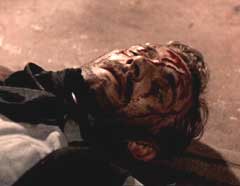
THE LIVING COFFIN is not that distinctive on a whole, but it does have some elements that makes it different than most of the other Mexican genre pictures of the era. First off, it’s in color, which was not very common. Second, it’s really a western with a number of gothic, haunting trappings tossed in to warrant its horror status. The ingredient of a sickly woman having a bell alarm affixed to her coffin in case of premature burial breathes of Poe, and the inclusion of the “crying woman” was a fixture in Mexican cinema. Here, she’s seen as a rotting corpse draped in a flowing shroud, creeping in an out of a secret crypt doorway. It’s somewhat startling to see the blood-drenched mutilated faces of several of her victims, especially considering when this was made.
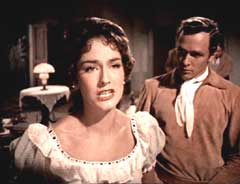 The
western motifs are carried in large by lead Gastón Santo, a star in his
own country not so much for his infrequent acting stints, but rather for being
a legendary bullfighter. Santo is made to look like an American cowboy idol,
not unlike Roy Rogers, and even has a trusty white horse that saves him from
a deadly quicksand pit and can sense danger in an instant. Santo (and his stuntman)
also takes part in a violent saloon fight in which he challenges a duo of varmints
who try and force him to take a swig of liquor (he doesn’t drink!). His
comic sidekick (de Aguillón) is strictly here for comic relief, as the
character is more interested in taking a nap on a comfortable mattress than
doing anything remotely heroic. THE LIVING COFFIN, with its modest 70+ minute
running time, is quite harmless and not a bad little film.
The
western motifs are carried in large by lead Gastón Santo, a star in his
own country not so much for his infrequent acting stints, but rather for being
a legendary bullfighter. Santo is made to look like an American cowboy idol,
not unlike Roy Rogers, and even has a trusty white horse that saves him from
a deadly quicksand pit and can sense danger in an instant. Santo (and his stuntman)
also takes part in a violent saloon fight in which he challenges a duo of varmints
who try and force him to take a swig of liquor (he doesn’t drink!). His
comic sidekick (de Aguillón) is strictly here for comic relief, as the
character is more interested in taking a nap on a comfortable mattress than
doing anything remotely heroic. THE LIVING COFFIN, with its modest 70+ minute
running time, is quite harmless and not a bad little film.
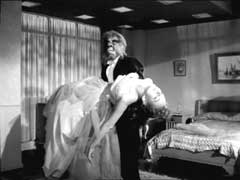
With these two releases, CasaNegra continues the standard of quality of their previous releases. THE MAN AND THE MONSTER is presented full frame in a sharp, clean black and white transfer, with deep blacks and excellent detail. THE LIVING COFFIN is presented full frame in a clean transfer, with the colors looking surprisingly very good. Both films contain their original Spanish language tracks (with optional English subtitles) as well as the English-dubbed tracks. The Spanish tracks are stronger, with the English tracks being occasionally scratchy (especially in the case of COFFIN), but they are still solid and their inclusion here is much appreciated since they're what most of us remember from the days of watching these on late-night TV.
CasaNegra has opted not to include commentaries on these two releases (as they have done so in the past), but there are still some welcomed extras to be had. THE MAN AND THE MONSTER includes a slideshow of poster art for Mexican horror films from the 1950s through the 1970s, cast biographies, a poster and still gallery and a amusing American radio spot for when it was released theatrically in the late 1960s. THE LIVING COFFIN includes cast biographies, a poster and still gallery and an excellent essay on Mexican horror westerns by David Wilt. Both DVDs can have their menus accessed in either English or Spanish. (George R. Reis)